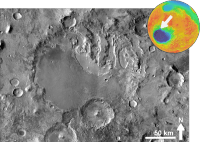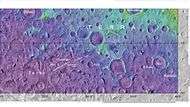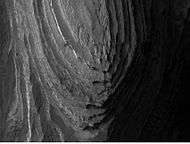Terby (crater)
 | |
| Planet | Mars |
|---|---|
| Coordinates | 28°18′S 285°54′W / 28.3°S 285.9°WCoordinates: 28°18′S 285°54′W / 28.3°S 285.9°W |
| Diameter | 174.0 km |
| Eponym | François J. Terby |
Terby is a crater on the northern edge of Hellas Planitia, Mars. It is in the Iapygia quadrangle.The 174 km diameter crater is centered at 28°S, 73°E with an elevation of −5 km. It is named after François J. Terby. It is the site of an ancient lakebed and has clay deposits.[1] Using data from Mars Global Surveyor, Mars Odyssey, Mars Express and Mars Reconnaissance Orbiter missions researchers believe Terby's layers were formed from sediments settling under water. Crater counts show this happened during the Noachian period. It used to be thought that Terby Crater contained a large delta.[2] However, newer observations have led researchers to think of the layered sequence as part of a group of layers that may have extended all the across Hellas. There is no valley large enough at the northern rim of Terby to have carried the large amount of sediments necessary to produce the layers. Other details in the layers argue against Terby containing a delta.[3] Fan deposits are some of the thickest on Mars. Hydrated minerals, including Fe/Mg phyllosilicates, have been detected in several layers.[4]
Impact craters in general
Impact craters generally have a rim with ejecta around them, in contrast volcanic craters usually do not have a rim or ejecta deposits. As craters get larger (greater than 10 km in diameter) they usually have a central peak.[5] The peak is caused by a rebound of the crater floor following the impact.[6] If one measures the diameter of a crater, the original depth can be estimated with various ratios. Because of this relationship, researchers have found that many Martian craters contain a great deal of material; much of it is believed to be ice deposited when the climate was different.[7] Sometimes craters expose layers that were buried. Rocks from deep underground are tossed onto the surface. Hence, craters can show us what lies deep under the surface.
Why are Craters important?
The density of impact craters is used to determine the surface ages of Mars and other solar system bodies.[5] The older the surface, the more craters present. Crater shapes can reveal the presence of ground ice.
The area around craters may be rich in minerals. On Mars, heat from the impact melts ice in the ground. Water from the melting ice dissolves minerals, and then deposits them in cracks or faults that were produced with the impact. This process, called hydrothermal alteration, is a major way in which ore deposits are produced. The area around Martian craters may be rich in useful ores for the future colonization of Mars.[8] Studies on the earth have documented that cracks are produced and that secondary minerals veins are deposited in the cracks.[9][10][11] Images from satellites orbiting Mars have detected cracks near impact craters.[12] Great amounts of heat are produced during impacts. The area around a large impact may take hundreds of thousands of years to cool.[13][14][15] Many craters once contained lakes.[16][17][18] Because some crater floors show deltas, we know that water had to be present for some time. Dozens of deltas have been spotted on Mars.[19] Deltas form when sediment is washed in from a stream entering a quiet body of water. It takes a bit of time to form a delta, so the presence of a delta is exciting; it means water was there for a time, maybe for many years. Primitive organisms may have developed in such lakes; hence, some craters may be prime targets for the search for evidence of life on the Red Planet.[20]
Images
 MOLA map showing Terby Crater and nearby craters. Colors indicate elevations.
MOLA map showing Terby Crater and nearby craters. Colors indicate elevations.- Map of Iapygia quadrangle with major craters.
 Terby crater - contains many rock layers.
Terby crater - contains many rock layers. Layers in Terby crater may have formed when the Hellas basin was filled with water.
Layers in Terby crater may have formed when the Hellas basin was filled with water.- Terby Crater layers as seen by HiRISE.
 Northern part of Terby Crater showing many layers, as seen by CTX camera (on Mars Reconnaissance Orbiter). Parts of this image are enlarged in next two images.
Northern part of Terby Crater showing many layers, as seen by CTX camera (on Mars Reconnaissance Orbiter). Parts of this image are enlarged in next two images. Northern part of Terby Crater showing many layers, as seen by CTX camera (on Mars Reconnaissance Orbiter).
Northern part of Terby Crater showing many layers, as seen by CTX camera (on Mars Reconnaissance Orbiter). Northern part of Terby Crater showing many layers, as seen by CTX camera (on Mars Reconnaissance Orbiter).
Northern part of Terby Crater showing many layers, as seen by CTX camera (on Mars Reconnaissance Orbiter).
See also
References
- ↑ Murchie, S. et al. 2009. A synthesis of Martian aqueous mineralogy after 1 Mars year of observations from the Mars Reconnaissance Orbiter. Journal of Geophysical Research: 114.
- ↑ Ansan, V. et al. 2005. Analysis of layered deposits in Terby crater Hellas region, Mars) using multiple datasets MOC, THEMIS, and OMEGA/MEX date. Lunar Planet. Sci., XXXVI (CD-ROM). Abstract 1324.
- ↑ Cabrol, N. and E. Grin (eds.). 2010. Lakes on Mars. Elsevier. NY.
- ↑ Ansan, V., D. Loizeau, M. Mangold, S., Le Mouélic, J. Carter, F. Poulet, G. Dromart, A. Lucas, J.-P. Bibring, A. Gendrin, B. Gondet, Y. Langevin, Ph. Massond, S. Murchie, J. Mustard, G. Neukum. 2011. Stratigraphy, mineralogy, and origin of layered deposits inside Terby crater, Mars. Icarus: 211, 273–304.
- 1 2 http://www.lpi.usra.edu/publications/slidesets/stones/
- ↑ Hugh H. Kieffer (1992). Mars. University of Arizona Press. ISBN 978-0-8165-1257-7. Retrieved 7 March 2011.
- ↑ Garvin, J., et al. 2002. Global geometric properities of martian impact craters. Lunar Planet Sci. 33. Abstract @1255.
- ↑ http://www.indiana.edu/~sierra/papers/2003/Patterson.html.
- ↑ Osinski, G, J. Spray, and P. Lee. 2001. Impact-induced hydrothermal activity within the Haughton impact structure, arctic Canada: Generation of a transient, warm, wet oasis. Meteoritics & Planetary Science: 36. 731-745
- ↑ http://www.ingentaconnect.com/content/arizona/maps/2005/00000040/00000012/art00007
- ↑ Pirajno, F. 2000. Ore Deposits and Mantle Plumes. Kluwer Academic Publishers. Dordrecht, The Netherlands
- ↑ Head, J. and J. Mustard. 2006. Breccia Dikes and Crater-Related Faults in Impact Craters on Mars: Erosion and Exposure on the Floor of a 75-km Diameter Crater at the Dichotomy Boundary. Special Issue on Role of Volatiles and Atmospheres on Martian Impact Craters Meteoritics & Planetary Science
- ↑ name="news.discovery.com"
- ↑ Segura, T, O. Toon, A. Colaprete, K. Zahnle. 2001. Effects of Large Impacts on Mars: Implications for River Formation. American Astronomical Society, DPS meeting#33, #19.08
- ↑ Segura, T, O. Toon, A. Colaprete, K. Zahnle. 2002. Environmental Effects of Large Impacts on Mars. Science: 298, 1977-1980.
- ↑ Cabrol, N. and E. Grin. 2001. The Evolution of Lacustrine Environments on Mars: Is Mars Only Hydrologically Dormant? Icarus: 149, 291-328.
- ↑ Fassett, C. and J. Head. 2008. Open-basin lakes on Mars: Distribution and implications for Noachian surface and subsurface hydrology. Icarus: 198, 37-56.
- ↑ Fassett, C. and J. Head. 2008. Open-basin lakes on Mars: Implications of valley network lakes for the nature of Noachian hydrology.
- ↑ Wilson, J. A. Grant and A. Howard. 2013. INVENTORY OF EQUATORIAL ALLUVIAL FANS AND DELTAS ON MARS. 44th Lunar and Planetary Science Conference.
- ↑ Newsom H. , Hagerty J., Thorsos I. 2001. Location and sampling of aqueous and hydrothermal deposits in martian impact craters. Astrobiology: 1, 71-88.
External links
| Wikimedia Commons has media related to Terby (Martian crater). |
- Evidence for Lacustrine Deposition at the crater Terby
- HiRISE observation of the crater Terby
- Mars Express views of Terby